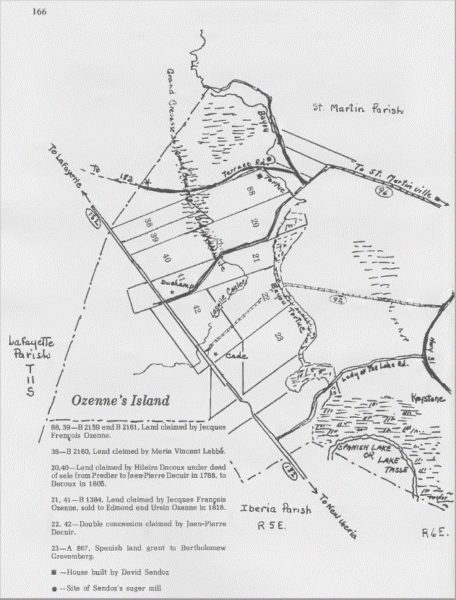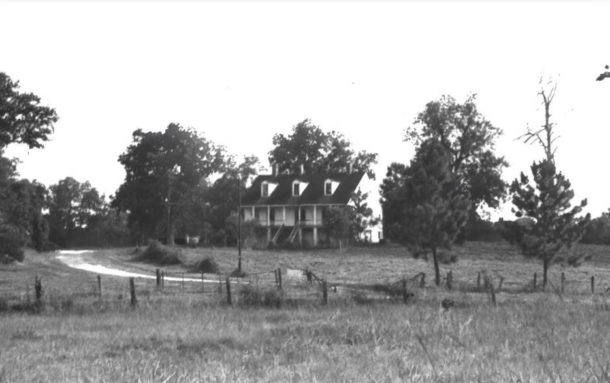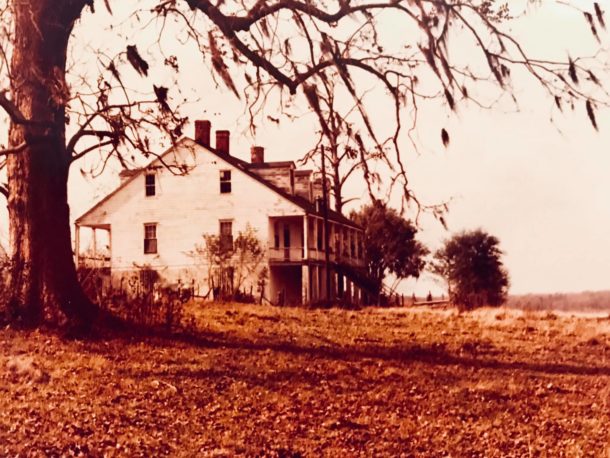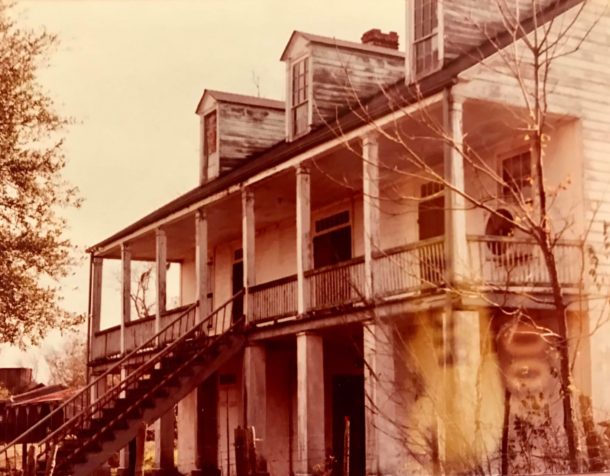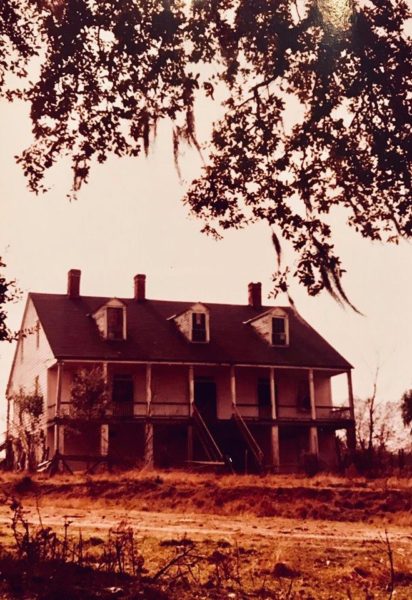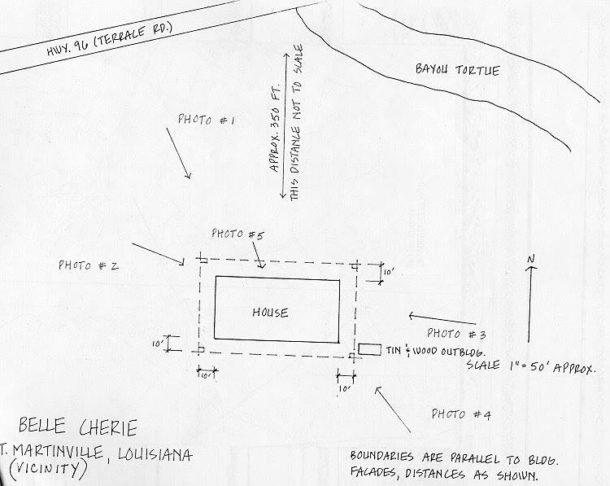ANNOTATIONS
The hill, with Bayou Tortue on one side and lowlands on the other, is said to be 45 feet above sea level. Once called "Ozenne’s Island,” it is one of a series of formations of sandy, red soil, probably deposited centuries ago by floodwaters rushing through what early settlers called the “Grande Crevasse." In later land transactions, it is called Beauvais Coulee. The entire area is known as "Cote Gelee.” (According to land descriptions, the Grande Crevasse is now called Cypress Bayou.)
In early times the Terrace Road did not exist even as a trail. Antoine Ozenne, great, great grandson of Jacques Francois Ozenne, recounts some of his ancestors’ stories of how they had to follow trails over the high lands on their way to St. Martinville in the early 1800s. (Interview with Antoine Ozenne. Aug. 12, 1900). Ozenne lives within earshot of the old Sandoz house and next to the site of the Sandoz sugar mill. There is also evidence that the Terrace Road was part of the stage route to Vermilionville in the mid-1800s. Its improvement as a graveled road connected to Highway 102 and then as a blacktop road can be considered fairly recent.
By Certificate B-2159, dated Feb. 20. 1813, Jacques Francois Ozenne acquired title to a tract 15 arpents wide bounded above by Bayou Tortue and below by the Grande Crevasse (the customary 40 arpents depth), founded on possession from January 29. 1781, as appears in the deed of conveyance from Widow Dauterive, dated March 11, 1786, and on cultivation and settlement from October 1. 1800, to November 20. 1803. A second claim, B-1384, for 11 arpents front on Bayou Tortue below the first claim was based on occupancy since 1700. Louisiana Register of State Land Claims. Indications are that Ozenne claimed possession of the lands but did not occupy them until some time later, probably not bringing his family into the area until after 1800.
In 1728 Jacques Ozenne, a native of St. Ines, Normandy, was employed by the Company of the Indies as a cooper. Glenn R. Conrad, comp.. The First Families of Louisiana, 2 vols. (Baton Rouge, La., 1970), I, 229. He was the son of Jacques Ozenne and Marie Demoulin of St. Ines, Normandy. November 10, 1729, he married Charlotte Julie Moreau in St. Louis Cathedral, New Orleans. Information furnished by Jacqueline O. Vidrine. Jacques Francois was born in 1740. He married Marguerite Decuir in Pointe Coupee in 1766. Bill Barron, ed.. Census of Pointe Coupee in Louisiana, 1745 (Baton Rouge. La., 1970), p. 01.
From the history of the church in St. Martinville. In early 1774, Jacques Francois Ozenne wrote Gabriel Fuselier de la Claire, commandant of the post, complaining that the residents were not paying: "I beg of you to ask the governor to see that it (the debt) is paid, for the residents have refused to pay not only for the wood but also for my trip to the Attakapas.” St. Martin Parish Conveyances, Bk. 1-a, No. 15. On May 1. 1774, Fuselier de la Claire forwarded the request to the governor.
A general census of the owners of immovable property, their slaves, and their assessments on the west bank of Bayou Tortue in 1808 lists family holdings as follows: Ozenne (pere), no slaves 12 arpents (sec. 21 and 41); Ursin. 1 slave. 0 arpents; Ozenne (fils), 2 slaves, 0 arpents; Edmond. 1 slave, 0 arpents; Ozenne (pere), 14 slaves, 15 arpents (sec. 88): M. V. Labbe, 4 slaves, one-half arpent. Mary Elizabeth Sanders, Records of the Attakapas District. Vol. Ill: St. Martin Parish, 1808-1860 (Privately printed. 1974).
Ursin’s marriage to Julie Picard is recorded in St. Martin of Tours Church. Donald J. Hebert, comp., Southwest Louisiana Records. 19 vols. (Privately printed, 1974-1979), II, 702.
Ibid., p. 240. Marie Vincent Labbe was certified in his claim to 7.5 arpents front by 40 arpents depth (sec. 38) behind his father-in-law’s claim (sec. 88) in 1813. In 1807 Jacques Francois Ozenne conveyed to his son-in-law the adjoining tract (sec. 39), which he had purchased from DeGruisse and wife. Louisiana Register of State Land Claims. DeGruisse's wife was the widow of Bernard Dauterive.
St. Martin Parish Successions. No. 292.
St. Martin Parish Conveyances, Book l-a. No. 2687.
Antoine Beauvais of Fausse Riviere married Marie Manon Ozenne in Pointe Couple in 1797. She is listed as the daughter of Jacques Francois Ozenne of Attakapas. Her groom was the son of Antoine St. Jammes-Beauvais of Illinois and Marie Riche. Veneta DeGraffenried Morrison, comp.. Index. Early Marriages of Pointe Coupee. 1771-1843 (Privately printed, n.d.). As in the case of Manon’s sister who married Jean-Baptist Beauvais of the Parish of Ste. Genevidve in 1793 (Winston Deville, comp., Colonial Marriage Contracts, Vol. Ill: Pointe Coupee. 1763-1803 [Baton Rouge, La.. 1962]), the parents of the bride were not present at the wedding. Suzanne and her husband settled on the west side of Bayou Tortue in the same area as her parents.
In the conveyance to Antoine Beauvais, Ozenne reserves a room for himself in the dwelling house on the property. St. Martin Parish Conveyance No. 3170.
St. Martin Parish Conveyances Nos. 3476 and 3477.
Last will and testament of Jacques Francois Ozenne, April 10, 1819. St. Martin Parish Successions, No. 327.
See Family Chart.
St. Martin Parish Conveyances, Book 20, No. 12247. This sale was for the tract of land 15 arpents wide, 40 arpents deep, designated section 88.
Ibid., No. 12272. David Francois Sandoz, born in Neuchatel, Switzerland, was the son of David Sandoz, Sr. and Marianne Mauley. The couple came to America from Switzerland. The gravestone in St. Martin Catholic Cemetery shows that she was born October 11, 1779, and died March 14, 1864. Her husband died about 1833.
David Sandoz II married Claire Christine Labbe (C-5) July 10, 1833. She was a first cousin of Julie Desiree Beauvais and a granddaughter of Jacques Francois Ozenne.
The fact that there was nothing on the property at the time of the sale leads to the conclusion that Sandoz built the house sometime after 1851. He, himself, was a builder, credited with the construction of several buildings on Main Street in St. Martinville. Just when he started work on this house and when he completed it is undetermined; however, Antoine Ozenne recalls that his grandmother, the daughter of David Sandoz had told how builders worked to install windows in the face of an approaching storm. (Interview with Antoine Ozenne).
This storm could have been the great hurricane of 1856, usually called the Last Island Storm, which was strongly felt in the area. The house in which Jacques Francois Ozenne reserved a room for himself (See above, footnote No. 11) must have been located on the half of the property that Alcide Fuselier did not sell to David Sandoz.
Construction details of the house show the use of hand-hewn timbers as well as those cut by circular and pit saws, and briquette' entre poteau along with bousillage. Antoine Ozenne credits slave labor for the variation in building detail, using the information handed down by his grandmother, Amelie Sandoz. (Interview with Antoine Ozenne).
David Sandoz married Claire Christine Labbe, daughter of Claire Ozenne and Marie Vincent Labbe and granddaughter of Jacques Francois Ozenne. Four of their six children died at an early age. A fifth, David Charles, died in the Civil War. *Marie Amdlie, born August 4, 1842, was their only heir. Her husband was the son of Jean-Baptiste Eugene Duchamp de Chastaigne and Marie Louise Euphemie Sophie Merope Martin de la Mertiniere of Martinique. The family came to the St. Martinville area from Morris County, New Jersey. Three of their fourteen children married two Ozennes and a Fuselier (See E-l, D-2, and D-3), and two more children married Duchamp .
The first mention of Providence Plantation is contained in the act of sale from Amelie Sandoz Duchamp to the Billeaud family in 1904. St. Martin Conveyances. Book 61. folio 416.
The old post office building, now the property of the town of St. Martinville, was once the Duchamp town house. This handsome structure, built about 20 years after the house in the country, offers a sharp contrast in style and detail. It is said that after Duchamp’s death in 1877, Amalie returned to the country to live again in the old plantation house.
St. Martin Parish Conveyances. Book 61. folio 413.
The act of donation from Mr. and Mrs. Nickerson to their children describes this tract of land with all buildings and improvements as 7.5 arpents wide and 40 arpents deep, containing 300 superficial arpents, bounded north by David Sandoz or assigns (this includes the Ozennes), south by the estate of Gabriel Fuselier and west by Labbe or assigns. Lafayette Parish Donations Book 138, p. 227.

